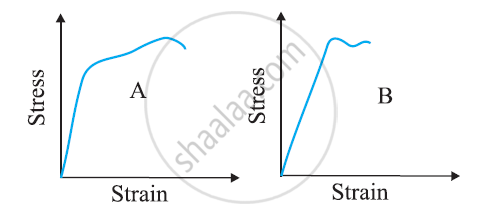Advertisements
Advertisements
प्रश्न
Two wires of diameter 0.25 cm, one made of steel and the other made of brass are loaded as shown in Fig. 9.13. The unloaded length of steel wire is 1.5 m and that of brass wire is 1.0 m. Compute the elongations of the steel and the brass wires.

उत्तर १
Elongation of the steel wire = 1.49 × 10–4 m
Elongation of the brass wire = 1.3 × 10–4 m
Diameter of the wires, d = 0.25 m
Hence, the radius of the wires, `r=d/2` = 0.125 cm
Length of the steel wire, L1 = 1.5 m
Length of the brass wire, L2 = 1.0 m
Total force exerted on the steel wire:
F1 = (4 + 6) g = 10 × 9.8 = 98 N
Young’s modulus for steel:
`Y_1 = (F_1/A_1)/(triangleL_1/L_1)`
Where,
ΔL1 = Change in the length of the steel wire
A1 = Area of cross-section of the steel wire = `pir_1^2`
Young’s modulus of steel, Y1 = 2.0 × 1011 Pa
`:.triangleL_1 = (F_1xxL_1)/(A_1xxY_1) = (F_1xxL_1)/(pir_1^2xxY_1)`
`= (98xx1.5)/(pi(0.125 xx 10^(-2))^2 xx 2 xx 10^11) = 1.49 xx 10^(-4)m`
Total force on the brass wire:
F2 = 6 × 9.8 = 58.8 N
Young’s modulus for brass: `Y_2 = (F_2/A_2)/((triangleL_2)/L_2)`
Where
`triangleL_2` = change in length
`A_2` = Area of cross-section of the brass wire
`:.triangleL_2 = (F_2xxL_2)/(a_2xxY_2) = (F_2xx L_2)/(pir_2^2 xx Y_2)`
`= (58.8 xx 1.0)/(pixx(0.125xx10^(-2))^2 xx (0.91xx10^(11))) = 1.3xx10^(-4)m`
Elongation of the steel wire = 1.49 × 10–4 m
Elongation of the brass wire = 1.3 × 10–4 m
उत्तर २
For steel wire total force on steel wire
F1 = 4+6 = 10 kg f = 10 x 9.8 N
l1 = 1.5 m, Δl1 = ?; 2r1 = 0.25 cm
or `r_1 = (0.25)/2 cm = 0.125xx 10^(-2) m`
`Y_1 = 2.0 xx 10^11` Pa
For brass wire, F2 = 6.0 kg f = 6 x 9.8 N
2r2 = 0.25 cm
or `r_2 = (0.25/2) = 0.125 xx 10^(-2) m`
`Y_2 = 0.91 xx 10^11 Pa`, `l_2 = 1.0 m` `trianglel_2 = ?`
Since` Y_1 = (F_1xxl_1)/(A_1xxtrianglel_1) = (F_1xxl_2)/(pir_1^2 xx trianglel_1) => trianglel_1 = (F_1xxl_1)/(pir_1^2xxtrianglel_1)`
or `trianglel_1 = ((10xx9.8)xx1.5xx7)/(22xx(0.125xx10^(-2))^2xx2xx10^11) = 1.49 xx 10^(-4) m`
And `trianglel_2 = (F_2xxl_2)/(pir_2^2 xx Y_2) = ((6xx9.8)xx1xx7)/(22xx(0.125xx10^(-2))^2xx(0.91xx10^11)) = 1.3 xx 10^(-4) m`
APPEARS IN
संबंधित प्रश्न
A steel wire of length 4.7 m and cross-sectional area 3.0 × 10–5 m2 stretches by the same amount as a copper wire of length 3.5 m and cross-sectional area of 4.0 × 10–5 m2 under a given load. What is the ratio of Young’s modulus of steel to that of copper?
The stress-strain graphs for materials A and B are shown in Figure

The graphs are drawn to the same scale.
(a) Which of the materials has the greater Young’s modulus?
(b) Which of the two is the stronger material?
Read the following statements below carefully and state, with reasons, if it is true or false
The Young’s modulus of rubber is greater than that of steel;
Two wires A and B are made of same material. The wire A has a length l and diameter rwhile the wire B has a length 2l and diameter r/2. If the two wires are stretched by the same force, the elongation in A divided by the elongation in B is
A wire elongates by 1.0 mm when a load W is hung from it. If this wire goes over a a pulley and two weights W each are hung at the two ends, he elongation of he wire will be
A steel rod of cross-sectional area 4 cm2 and 2 m shrinks by 0.1 cm as the temperature decreases in night. If the rod is clamped at both ends during the day hours, find the tension developed in it during night hours. Young modulus of steel = 1.9 × 1011 N m−2.
The temperature of a wire is doubled. The Young’s modulus of elasticity ______.
In nature, the failure of structural members usually result from large torque because of twisting or bending rather than due to tensile or compressive strains. This process of structural breakdown is called buckling and in cases of tall cylindrical structures like trees, the torque is caused by its own weight bending the structure. Thus the vertical through the centre of gravity does not fall within the base. The elastic torque caused because of this bending about the central axis of the tree is given by `(Ypir^4)/(4R) . Y` is the Young’s modulus, r is the radius of the trunk and R is the radius of curvature of the bent surface along the height of the tree containing the centre of gravity (the neutral surface). Estimate the critical height of a tree for a given radius of the trunk.
A metal wire of length L, area of cross section A and Young's modulus Y behaves as a spring of spring constant k given by:
A uniform metal rod of 2 mm2 cross section is heated from 0°C to 20°C. The coefficient of linear expansion of the rod is 12 × 10-6/°C, it's Young's modulus is 1011 N/m2. The energy stored per unit volume of the rod is ______.
